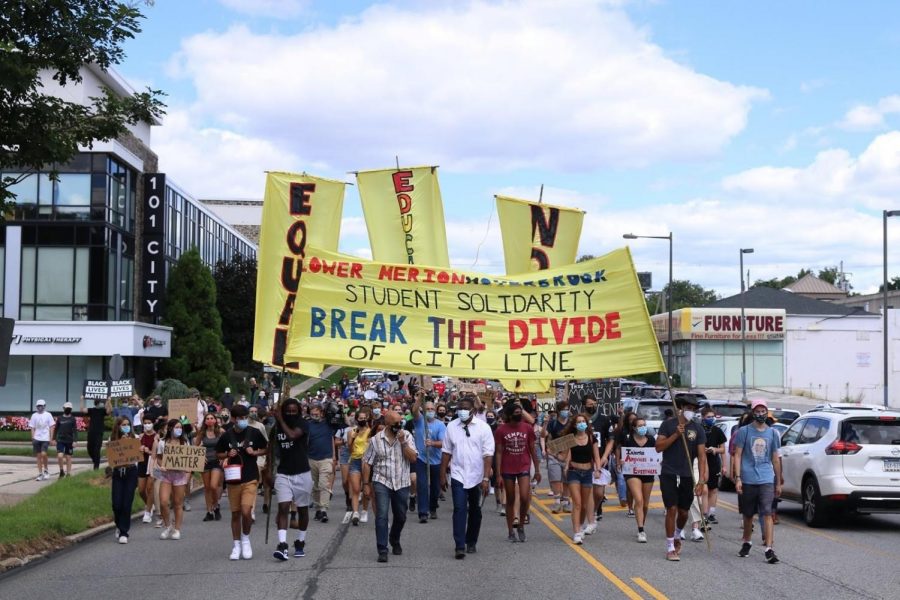Students Protest to Break the Divide of City Line
Harriton, Lower Merion, and Overbrook High School Students March Together
On Sunday, August 30, approximately 200 people attended a local march from Cynwyd Station Park in Bala Cynwyd to Tustin Playground in Overbrook. It was organized to bring awareness to how funding disproportionately affects public urban and suburban schools.
This demonstration starkly revealed the privilege differences in education between Lower Merion and Overbrook High School, which are only several miles away from each other.
As someone who has attended numerous Black-Lives-Matter-related protests in the city this summer, I was excited to compare the local event to national events. The rally started at Cynwyd Station Park in Bala Cynwyd, right near the popular Cynwyd Heritage Trail. Upon arrival, I noticed at least five police cars on the street, an unnecessary amount for any protest.
The rally began with speeches by the organizers, four Lower Merion High School seniors, Megan Craig; Michaela Craig; Kisara Freeman; and Caitlin McGinty. They presented their goals for the protest and provided some facts on racial disparities in schools.
For instance, McGinty shared the racist history of the SAT. The SAT (Standard Aptitude Test) was created by the eugenicist, Carl Brigham, to identify the most intelligent white students for college admissions; Brigham argued this would prove the superiority of white people over black people.
Protesters were also informed that $31 million is spent on policing Philadelphia schools, which are predominantly BIPOC students. Minority students––especially black students––have often expressed how unsafe and uncomfortable they feel with police officers being in their schools, their supposed “safe spaces.”
Kayla Trimble, a West Philadelphia teacher, grew up in Lower Merion and attended Harriton High School. She noted the immediate differences between rich, heavily-white Harriton and West Philly’s poorer, primarily-BIPOC community.
In LMSD, every child is guaranteed access to electronic devices––especially in high school, with the one-to-one laptop program––, while her students received one tablet per every three kids.
Lower Merion School District does not have any police in their schools, besides a low key security guard at the schools’ entrances. Philadelphia needs to allocate its funds to increasing educational opportunities for minority students, to school mental health professionals, and to teachers.
We also cannot ignore the reality that black students do have equal access compared to white people when it comes to education in both K-12 and higher education. In economically depressed neighborhoods, less money is spent on essentials like books, computers, nurses, and counselors. These students have fewer opportunities to attend higher-level classes, too, whether it be because of lack of funding, or because they are often discouraged by counselors and teachers.
At the rally, there were also speeches given by public school teachers, students, and representatives from activist organizations, such as, I Will Breathe; Philadelphia Student Union; and Melanated Educators Collective. These groups––among others––have been active at the recent Black Lives Matter protests.
There was even a speech by Pennsylvania state senator, Vincent Hughes, who disparaged how Lower Merion was able to spend $10,000 more per student than per Philadelphia student.
Senator Hughes, along with Reverend Gregory Holston, had previously walked the four miles from Overbrook to Lower Merion High School to meet with Lower Merion administration. This action demonstrated that despite how close the two schools are, there are substantial monetary and educational differences as soon as one crosses City Ave.
After speeches concluded, the organizers encouraged any students present to help lead the march, which flooded City Ave’s traffic-heavy streets.
The final destination was Tustin Playground, right across the street from Overbrook High School in Philadelphia. Similar to the starting location, speeches were delivered by others active in the education community, including Reverend Gregory Holston and Zion Brooks (daughter of Councilwoman Kendra Brooks).
This is not a moment; it is a movement, and the moral of the movement is we are not only plagued by a COVID-19 pandemic but an ongoing pandemic of racism, as well. Racism occurs within all institutions, and the racism-hotspots we call schools are no exception.
As can be expected at protests, chants were heard throughout the entire 50-minute march. Police cars were driving slowly ahead of the crowd, so it was noted that they were in earshot of chants of “no good cop in a racist system!” and “f*ck 12!”

Julianna Schweitzer is a senior and is excited to be a part of The Banner for her second year, and this year as one of the communications directors. As...



